How To Apply Semi Transparent Stain To A Fence
Fence Staining Made Easy
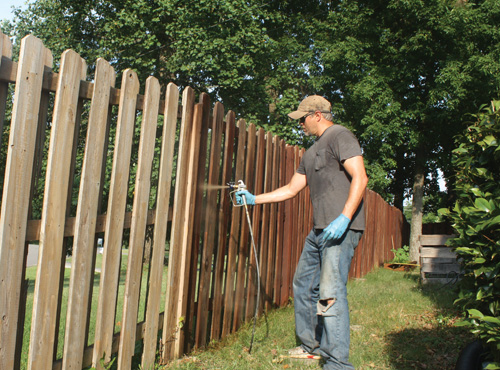
Protect and beautify your outdoor wood—fast.
By Matt Weber
It's no secret that outdoor wood requires routine maintenance to keep it in good shape. In the shade it's susceptible to mildew, and in the sun it's punished by ultraviolet rays that give it that aged, gray appearance. To maintain its beauty the wood must be periodically cleaned and preserved, and DIY homeowners are always looking for a better way to get the job done.
When it came time to re-stain a shadowbox fence, I wanted to work smarter rather than harder, so I tried a promising product called Ready Seal. This is an oil-based semi-transparent wood stain and sealer in one. Ready Seal is a professional-grade product, but is formulated with unique "goof proof" features that make it especially attractive for do-it-yourselfers.
Typical wood stains require back-brushing to smooth out runs, streaks and brush marks and to work the coating into the grain. I was dreading this part of the job. Spraying typical wood stains requires spraying one section of the project at a time and immediately back-brushing the area to prevent lap marks or runs. The back-brushing process requires a helper, or it requires the person spraying to serve double-duty by performing both jobs. This involves a great deal of labor, especially on vertical surfaces such as fences. If you eliminate the back-brushing, you eliminate half the work, making the project much easier for a lone DIY'er like myself. Ready Seal is formulated to require no back-brushing, and that's the selling point that convinced me to try the product.

Outdoor wood accumulates all sorts of dirt and grime, so the surface must be thoroughly cleaned before staining and sealing.
Plus, the product is a penetrating sealer, which I prefer over the film-forming type. Instead of forming a rigid film on the wood surface, Ready Seal penetrates deep into wood fibers with waterproofing oils to create a flexible barrier that keeps moisture out. The oils expand and contract so the coating won't crack, chip, flake or peel, which can lead to failure.
It turns out that it's also easy to apply with an airless sprayer. Whereas some finishing products require a multi-step application process, Ready Seal is formulated to add color and seal the wood from moisture in one step. This saves time, money and sweat.
Clean the Wood Surface
Over time a fence can accumulate all sorts of grime on the wood surface. From airborne dirt, pollen, mildew or even mold, all this gunk deteriorates the look of the wood and if left neglected can eventually lead to rot. All the loose grime should be cleaned away. One method is to use a long-handled scrub brush with a wood detergent and even follow up with a wood brightener to open the grain to accept new preservative. You can't skip the cleaning step or even skimp on the work. If you apply stain/sealer over grime or mildew, you aren't staining a fence, you're staining the grime.
It will look ugly, the coating won't absorb evenly, it won't have the proper preservative properties, and it will come off the fence when the grime detaches.
An alternative method to cleaning the fence is to use a pressure-washer. The high-pressure water stream not only blasts away grime and mildew but it can peel away the outer layer of the wood's dead gray cells and expose the lighter, fresher wood grain.
Whereas some professionals advise against using a pressure-washer on outdoor wood decks, I throw that advice out the window when it comes to a fence. The conventional wisdom suggests the high-pressure water can damage the woodgrain, giving it a fuzzy appearance and texture. This is primarily a concern for walking surfaces because homeowners typically want smooth deck boards with little chance of picking up a splinter when walking barefoot. Nobody walks on a fence, though, so I say blast away.
When using a power-washer, carefully work in the direction of the grain—never against it, which can result in a noticeable cut across the wood.
Prep the Sprayer
The easiest, most productive way to spray a very large project like this is to use an airless sprayer. An airless unit draws stain or paint directly from a paint canister and sprays at pressures up to 1,700 PSI.
Whether you're purchasing, renting or borrowing one of these units, it's important to understand they require additional care to make sure they're in proper working order. Airless sprayers must be flushed and tested each time a new job is started to ensure no contaminants from previous jobs will mix with the product you intend to apply. Follow the sprayer manufacturer's instructions for circulating the solvent used to clean the equipment. For latex paints, many pros prefer to use clean water, but an oil-based stain like this requires mineral spirits.
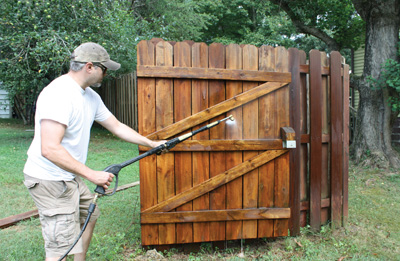
First step is to pressure-wash the fence to rejuvenate the wood.
Once the system has been flushed and drained, you can load the stain/sealer of your choice. Mix the product thoroughly and strain the stain/sealer through a paint screen to keep solid particles out of the system.
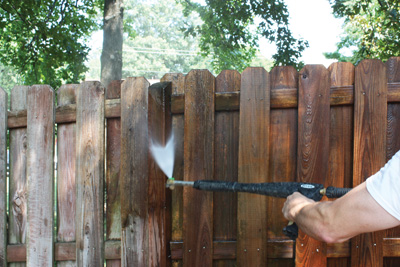
I used the Hyde Pivot Nozzle Wand, which pivots with the twist of the handle to direct the water stream where you want it.
Before spraying the new coating, discharge the sprayer into a bucket to flush all the mineral spirits out of the hose. Hold the trigger until the gun begins to spray the stain you plan to apply, otherwise you'll end up hosing down your project with mineral spirits.
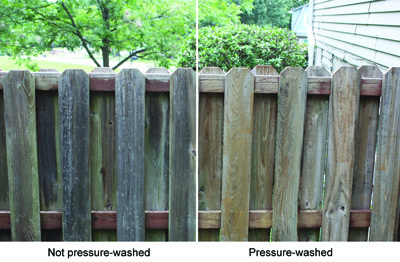
After the fence dries from the washing, it becomes evident how much dead wood and grime pressure-washing can remove.
Applying the Stain/Sealer
Movement is extremely important when using an airless sprayer. To avoid excessive stain accumulation, don't pull the trigger unless the gun is in motion. Squeeze the trigger as you move into a spraying pass over the work surface. Keep your wrist straight and the spray nozzle parallel to the fence boards for consistent application (rather than flexing your wrist and swinging the gun, which causes overspray). Start at the top and work downward.
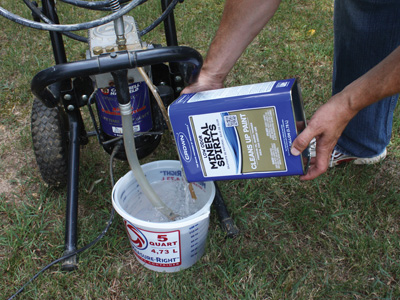
Airless sprayers must be flushed and tested each time a new job is started.
For applying oil-based stain, I recommend using a .011-.013-in. tip size for the spray gun.
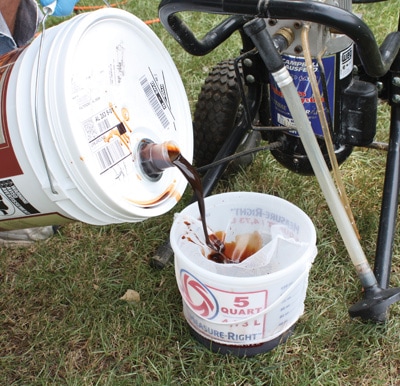
It's always best to strain the stain/sealer when using an airless sprayer to keep solid particles out of the system.
Don't forget to apply the coating to the end grain of the boards, which really drinks up moisture and requires extra protection.
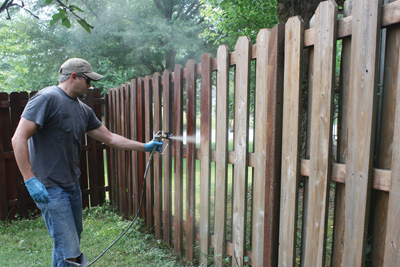
Spraying the fence was easy, but back-brushing the stain was even easier (no back-brushing required!).
Once the job is over, follow the manufacturer's instructions for cleaning and flushing the machine using the appropriate solvent. This is an absolutely critical step and ensures the airless sprayer will be properly stored without contaminants that gunk up the system, so it will be ready for the next job.
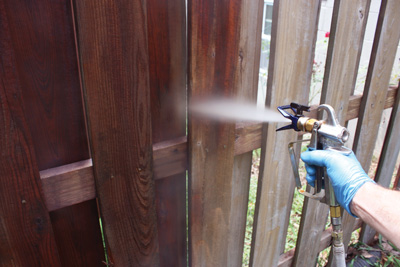
To minimize runs and overspray, keep the sprayer nozzle 10" to 12" away from the surface when applying the stain.
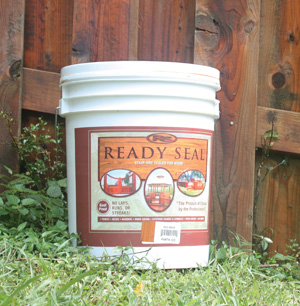
At the end of the project the results looked great, and I was able to save lots of time and labor by not having to back-brush.
In the end, the project was a success. After a day of spraying Ready Seal's redwood tone stain/sealer, the fence looked good as new. Not bad for a one-man job.
Editor's Note: Special thanks to Ready Seal for providing the stain/sealer for this product.
The results were fantastic. Visit www.readyseal.com.
Side Note
Smooth Moves

For smaller surfaces that need a touch-friendly surface, such as chairs, swings and benches, sanding is the best way to go. Use a random orbital sander and start with an 80-grit abrasive for material removal. Gradually progress to finer abrasives until the wood surface is smooth enough for a new coat of stain/sealer.
Recommended Articles
How To Apply Semi Transparent Stain To A Fence
Source: https://extremehowto.com/fence-staining-made-easy/
Posted by: woodberryandever.blogspot.com

0 Response to "How To Apply Semi Transparent Stain To A Fence"
Post a Comment